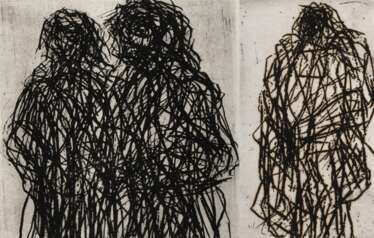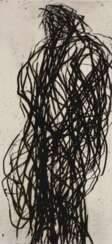udo nöger (1961)

Udo Nöger is a German and American artist working between San Diego, Miami and Geneva.
Nöger, who grew up in Enger, Germany, emigrated to the United States in the early 1990s. Early in his career, he was known for his expressive figurative paintings. These mixed-media works often feature enigmatic archaic figures and symbolically charged imagery inspired by his travels. On one such trip to the South Pacific, Nöger discovered ancient writings consisting of images of animals, figures and symbols used by the Easter Islanders centuries ago. Over time, he began to incorporate this ancient iconography into his work, eventually creating his own pictorial language that gradually became more and more abstract.
By the mid-nineties, Nöger began to focus exclusively on the interplay of light, space and color. The artist creates luminous monochrome paintings that capture light, movement and energy expressed in extremely minimalist compositions. Nöger uses an almost architectural approach to create works that seem to radiate light from within. The paintings consist of three layers of canvas mounted on stretchers set at a distance from each other.
Udo Nöger has exhibited many times around the world, and his works are in the permanent collections of the Metropolitan Museum of Art (New York), the Museum of Contemporary Art (Denver), the Art Institute of Chicago and others.
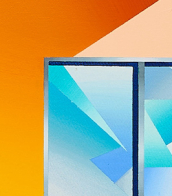

Udo Nöger is a German and American artist working between San Diego, Miami and Geneva.
Nöger, who grew up in Enger, Germany, emigrated to the United States in the early 1990s. Early in his career, he was known for his expressive figurative paintings. These mixed-media works often feature enigmatic archaic figures and symbolically charged imagery inspired by his travels. On one such trip to the South Pacific, Nöger discovered ancient writings consisting of images of animals, figures and symbols used by the Easter Islanders centuries ago. Over time, he began to incorporate this ancient iconography into his work, eventually creating his own pictorial language that gradually became more and more abstract.
By the mid-nineties, Nöger began to focus exclusively on the interplay of light, space and color. The artist creates luminous monochrome paintings that capture light, movement and energy expressed in extremely minimalist compositions. Nöger uses an almost architectural approach to create works that seem to radiate light from within. The paintings consist of three layers of canvas mounted on stretchers set at a distance from each other.
Udo Nöger has exhibited many times around the world, and his works are in the permanent collections of the Metropolitan Museum of Art (New York), the Museum of Contemporary Art (Denver), the Art Institute of Chicago and others.


Udo Nöger is a German and American artist working between San Diego, Miami and Geneva.
Nöger, who grew up in Enger, Germany, emigrated to the United States in the early 1990s. Early in his career, he was known for his expressive figurative paintings. These mixed-media works often feature enigmatic archaic figures and symbolically charged imagery inspired by his travels. On one such trip to the South Pacific, Nöger discovered ancient writings consisting of images of animals, figures and symbols used by the Easter Islanders centuries ago. Over time, he began to incorporate this ancient iconography into his work, eventually creating his own pictorial language that gradually became more and more abstract.
By the mid-nineties, Nöger began to focus exclusively on the interplay of light, space and color. The artist creates luminous monochrome paintings that capture light, movement and energy expressed in extremely minimalist compositions. Nöger uses an almost architectural approach to create works that seem to radiate light from within. The paintings consist of three layers of canvas mounted on stretchers set at a distance from each other.
Udo Nöger has exhibited many times around the world, and his works are in the permanent collections of the Metropolitan Museum of Art (New York), the Museum of Contemporary Art (Denver), the Art Institute of Chicago and others.


Udo Nöger is a German and American artist working between San Diego, Miami and Geneva.
Nöger, who grew up in Enger, Germany, emigrated to the United States in the early 1990s. Early in his career, he was known for his expressive figurative paintings. These mixed-media works often feature enigmatic archaic figures and symbolically charged imagery inspired by his travels. On one such trip to the South Pacific, Nöger discovered ancient writings consisting of images of animals, figures and symbols used by the Easter Islanders centuries ago. Over time, he began to incorporate this ancient iconography into his work, eventually creating his own pictorial language that gradually became more and more abstract.
By the mid-nineties, Nöger began to focus exclusively on the interplay of light, space and color. The artist creates luminous monochrome paintings that capture light, movement and energy expressed in extremely minimalist compositions. Nöger uses an almost architectural approach to create works that seem to radiate light from within. The paintings consist of three layers of canvas mounted on stretchers set at a distance from each other.
Udo Nöger has exhibited many times around the world, and his works are in the permanent collections of the Metropolitan Museum of Art (New York), the Museum of Contemporary Art (Denver), the Art Institute of Chicago and others.


Udo Nöger is a German and American artist working between San Diego, Miami and Geneva.
Nöger, who grew up in Enger, Germany, emigrated to the United States in the early 1990s. Early in his career, he was known for his expressive figurative paintings. These mixed-media works often feature enigmatic archaic figures and symbolically charged imagery inspired by his travels. On one such trip to the South Pacific, Nöger discovered ancient writings consisting of images of animals, figures and symbols used by the Easter Islanders centuries ago. Over time, he began to incorporate this ancient iconography into his work, eventually creating his own pictorial language that gradually became more and more abstract.
By the mid-nineties, Nöger began to focus exclusively on the interplay of light, space and color. The artist creates luminous monochrome paintings that capture light, movement and energy expressed in extremely minimalist compositions. Nöger uses an almost architectural approach to create works that seem to radiate light from within. The paintings consist of three layers of canvas mounted on stretchers set at a distance from each other.
Udo Nöger has exhibited many times around the world, and his works are in the permanent collections of the Metropolitan Museum of Art (New York), the Museum of Contemporary Art (Denver), the Art Institute of Chicago and others.


Udo Nöger is a German and American artist working between San Diego, Miami and Geneva.
Nöger, who grew up in Enger, Germany, emigrated to the United States in the early 1990s. Early in his career, he was known for his expressive figurative paintings. These mixed-media works often feature enigmatic archaic figures and symbolically charged imagery inspired by his travels. On one such trip to the South Pacific, Nöger discovered ancient writings consisting of images of animals, figures and symbols used by the Easter Islanders centuries ago. Over time, he began to incorporate this ancient iconography into his work, eventually creating his own pictorial language that gradually became more and more abstract.
By the mid-nineties, Nöger began to focus exclusively on the interplay of light, space and color. The artist creates luminous monochrome paintings that capture light, movement and energy expressed in extremely minimalist compositions. Nöger uses an almost architectural approach to create works that seem to radiate light from within. The paintings consist of three layers of canvas mounted on stretchers set at a distance from each other.
Udo Nöger has exhibited many times around the world, and his works are in the permanent collections of the Metropolitan Museum of Art (New York), the Museum of Contemporary Art (Denver), the Art Institute of Chicago and others.



Jörg Immendorff was a German painter and sculptor, stage designer and decorator, and a member of the New Wild movement.
Immendorff painted in cycles that often lasted for years and were political in nature. His series of sixteen large paintings, Café Deutschland (1977-1984), is well known. In these colorful paintings, numerous disco lovers symbolize the conflict between East and West Germany.
Immendorff prepared several stage productions and designed sets for the operas Elektra and The Rider's Voyage. 25 of Immendorf's paintings were selected in 2006 for the illustrated Bible.

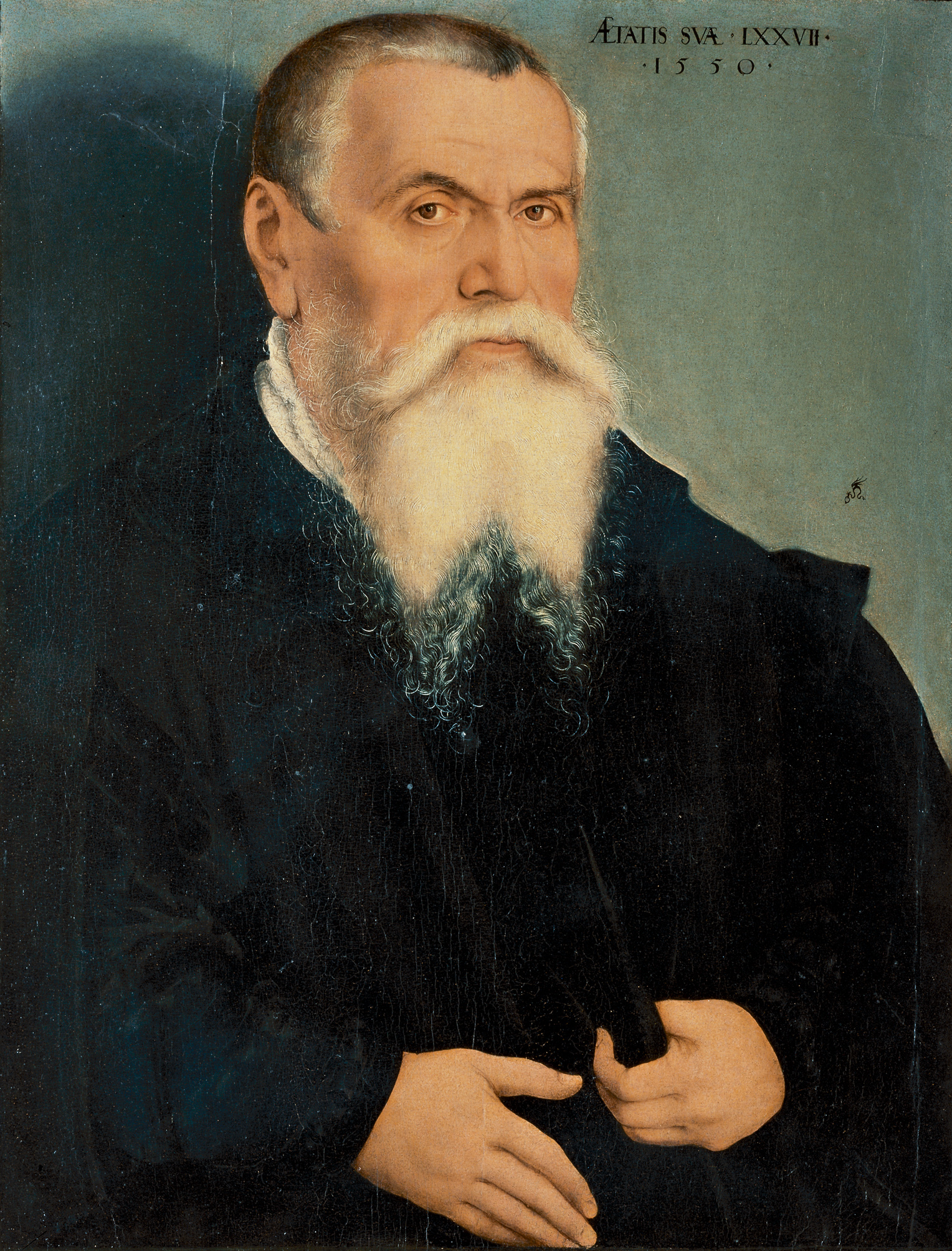
Lucas Cranach the Elder was a pivotal figure in German Renaissance art. As a leading painter of Saxony, his influence spanned across the 16th century, making significant contributions through his paintings, woodcuts, and engravings. His artistic journey began under the tutelage of his father, Hans Maler, and saw him becoming court painter to the Elector of Saxony, where he produced a vast array of works including altarpieces, court portraits, and notably, portraits of Protestant Reformers.
Cranach's artistry was not confined to any single genre. He was renowned for his portraits of the aristocracy, deeply symbolic religious paintings, and engaging mythological scenes. His ability to capture the essence of the Protestant Reformation, notably through his portraits of Martin Luther, showcases his close connection to the movement and his role as a key figure in conveying its ideals through art.
A significant part of Cranach's legacy is his workshop in Wittenberg, which was a hub of artistic production. This workshop produced numerous works that bore his distinctive winged serpent signature, a mark of quality and innovation in the art of the period. Cranach's workshop was known for its efficient operation, enabling the production of a large volume of works that catered to the high demand of his time.
For collectors and experts in art and antiques, Lucas Cranach the Elder's work represents an intriguing intersection of art, culture, and history. His contributions to Renaissance art and his unique portrayal of religious and mythological themes continue to captivate audiences, making his work highly sought after in the world of art collection.
To explore more about Lucas Cranach the Elder's fascinating contributions to art and to stay updated on new discoveries or auction events related to his works, consider signing up for specialized updates. This subscription is designed for enthusiasts keen on delving deeper into the rich tapestry of Renaissance art and history, ensuring they remain well-informed of relevant sales and scholarly insights.
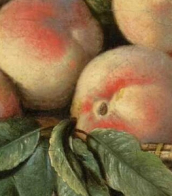

Paul Gauguin, a French artist born in Paris in 1848, is renowned for his significant contributions to Post-Impressionism, Primitivism, and Synthetism. Gauguin's art is distinguished by his experimental use of color and style, which set him apart from the traditional Impressionist movement.
Gauguin's early life was marked by a period in Peru, which influenced his artistic perspective. Initially, he pursued a career in stockbroking but soon turned to art, driven by financial necessity and a growing passion. His artistic journey began under the mentorship of Impressionist artist Camille Pissarro and through exposure to the works of other avant-garde artists.
The hallmark of Gauguin's work is his exploration of non-Western cultures, particularly during his time in Tahiti and the Marquesas Islands. This period saw the creation of some of his most famous works, including "Where Do We Come From? What Are We? Where Are We Going?" His paintings from this era, characterized by vivid colors and Symbolist themes, reflect a fusion of cultural influences and his quest for a "primitive" expression of spiritual and emotional states.
Despite his innovative style, Gauguin struggled with financial difficulties and health issues throughout his life. His work received little recognition during his lifetime, but posthumously, he gained acclaim for influencing modern artists like Pablo Picasso and Henri Matisse.
Today, Gauguin's works are celebrated in galleries and museums worldwide for their unique blend of cultural influences and artistic innovation. His enduring legacy is a testament to his unique vision and the profound impact he had on the art world.
Collectors and experts in art and antiques, stay updated on new product sales and auction events related to Paul Gauguin. Sign up now for exclusive updates and immerse yourself in the world of this visionary artist.


André-Aimé-René Masson was a French artist, celebrated for his profound influence on the world of modern art, particularly in painting and sculpture. Born in 1896, Masson's work is emblematic of the Surrealist movement, although his style evolved across different phases throughout his career. His ability to fuse dream-like imagery with abstract forms set him apart from his contemporaries, making him a pivotal figure in the development of Surrealism and beyond.
Masson's art is characterized by its dynamic forms and the integration of automatic drawing, where the unconscious mind is allowed to express itself without rational oversight. This technique not only foregrounded Surrealism's fascination with the subconscious but also highlighted Masson's unique ability to capture the complexity of human emotion and thought on canvas. His works, such as "The Metamorphosis of the Lovers" and "Battle of Fishes," are not just visual experiences but portals to the intricate layers of the psyche, showcasing his mastery over both form and content.
Notably, André-Aimé-René Masson's contributions extend beyond individual creativity; his works are housed in prestigious museums and galleries worldwide, including the Museum of Modern Art in New York and the Centre Georges Pompidou in Paris. These institutions recognize Masson's art not merely as aesthetic achievements but as cultural landmarks that continue to inspire and provoke. His legacy persists, offering rich insights into the intersections of art, psychology, and philosophy.
For collectors and experts in art and antiques, André-Aimé-René Masson's oeuvre represents a fascinating exploration of the Surrealist movement and its enduring impact on modern and contemporary art. His innovative approach to painting and sculpture invites ongoing discussion and appreciation among enthusiasts and scholars alike. We invite you to sign up for updates on new product sales and auction events related to André-Aimé-René Masson, ensuring you stay informed about opportunities to engage with the remarkable legacy of this pivotal artist. This subscription is your gateway to the forefront of art collection, focusing exclusively on Masson's influential body of work.
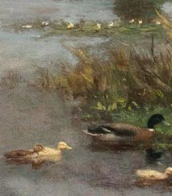

André-Aimé-René Masson was a French artist, celebrated for his profound influence on the world of modern art, particularly in painting and sculpture. Born in 1896, Masson's work is emblematic of the Surrealist movement, although his style evolved across different phases throughout his career. His ability to fuse dream-like imagery with abstract forms set him apart from his contemporaries, making him a pivotal figure in the development of Surrealism and beyond.
Masson's art is characterized by its dynamic forms and the integration of automatic drawing, where the unconscious mind is allowed to express itself without rational oversight. This technique not only foregrounded Surrealism's fascination with the subconscious but also highlighted Masson's unique ability to capture the complexity of human emotion and thought on canvas. His works, such as "The Metamorphosis of the Lovers" and "Battle of Fishes," are not just visual experiences but portals to the intricate layers of the psyche, showcasing his mastery over both form and content.
Notably, André-Aimé-René Masson's contributions extend beyond individual creativity; his works are housed in prestigious museums and galleries worldwide, including the Museum of Modern Art in New York and the Centre Georges Pompidou in Paris. These institutions recognize Masson's art not merely as aesthetic achievements but as cultural landmarks that continue to inspire and provoke. His legacy persists, offering rich insights into the intersections of art, psychology, and philosophy.
For collectors and experts in art and antiques, André-Aimé-René Masson's oeuvre represents a fascinating exploration of the Surrealist movement and its enduring impact on modern and contemporary art. His innovative approach to painting and sculpture invites ongoing discussion and appreciation among enthusiasts and scholars alike. We invite you to sign up for updates on new product sales and auction events related to André-Aimé-René Masson, ensuring you stay informed about opportunities to engage with the remarkable legacy of this pivotal artist. This subscription is your gateway to the forefront of art collection, focusing exclusively on Masson's influential body of work.

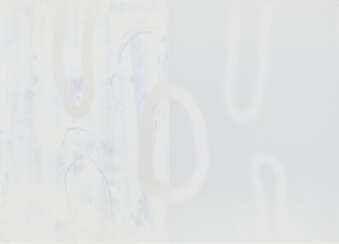














![[ARTE NUCLEARE] - Registratore nucleare. Milano: Galleria Schwarz, s.d. [1962] - TRISTAN SAUVAGE (pseudonimo di Arturo Schwarz). Nuclear Art. N.Y.: Maestro, 1962.](/assets/image/picture_1242590/b4975/upizrszditwku966ojqowh6akx8rt9optkqfyi5ukd0kyajzermpsd81zoneam51608651687jpg__fix_374_244.jpeg)
![[ARTE NUCLEARE] - Registratore nucleare. Milano: Galleria Schwarz, s.d. [1962] - TRISTAN SAUVAGE (pseudonimo di Arturo Schwarz). Nuclear Art. N.Y.: Maestro, 1962.](https://veryimportantlot.com/assets/image/picture_1242590/b4975/upizrszditwku966ojqowh6akx8rt9optkqfyi5ukd0kyajzermpsd81zoneam51608651687jpg__fix_374_244.jpeg)






















